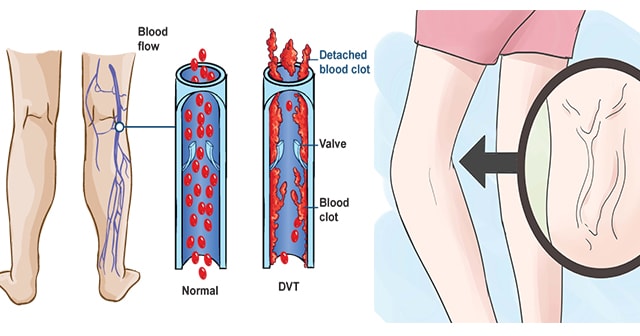A blood clot is a coagulation of blood that may develop after an injury to avoid excessive bleeding at the site of injury. Plasma contents such as platelets and proteins work together to form a clot at the affected area. This clot usually dissolved when the injury heals.

A clot may accumulate inside a vein or an artery even without injury and do not break down by itself, Resulting either stroke or pulmonary embolism.
Here are the types of Blood Clots:
1. ARTERIAL BLOOD CLOTS
A blood clot may accumulate in the blood vessels, either in veins or arteries. Veins carry unoxygenated blood back to the heart while arteries carry oxygenated blood away from the heart.
Arterial clots which are present in the arteries will block the blood and oxygen in the essential organs like brain and heart that leads to a stroke or even heart attack.
HERE ARE THE SYMPTOMS OF ARTERIAL CLOTS
-Loss of color to the affected area
-Muscle spasm or pain in the affected part
Tingling sensation or numbness in your leg or arm
-Weakness of the affected area
-Cold legs or arms
-Loss of color to the affected area
-Hands feel cold to touch
HERE ARE THE RISK FACTORS FOR ARTERIAL CLOTS
-Diabetes
-Obesity
-Hypertension
-High Cholesterol level
-Lack of physical activity/exercise
-Smoking
2. VENOUS BLOOD CLOTS
Venous blood clots are present in our veins. It usually occurs after a surgery or trauma (ex. broken leg). As a matter of fact, there are three kinds of a venous blood clot, the PE (pulmonary embolism), DVT (deep vein thrombosis), and Superficial thrombosis.
– PE usually occur from a deep vein thrombosis that has been damaged and eventually reached the lungs.
– DVT usually occurs in the thigh, lower leg, pelvis. Other sites of thrombosis are in the kidneys, liver, arm, intestines, and brain.
– Superficial Venous Thrombosis: They form in the veins which are the closest to the surface of the skin and they need an immediate treatment.
HERE ARE THE SYMPTOMS OF VENOUS BLOD CLOT
-painful vein and difficult to touch
-Reddish skin at the affected part
-Inflamed, swollen, and painful skin on the affected vein
TIPS TO PREVENT BLOOD CLOT.
1. Healthy Diet
Avoid eating food that affects the health of our Heart like food rich in trans fat, processed food, artificial sweeteners, food with high sugar level, and refined carbohydrates.
2. Active Lifestyle
Doing nothing in a day just sitting and sleeping is bad for the health, you need to exercise daily in order to attain a good health. If you have a sedentary work, at least stretch, stand or walk from time to time.
3. Medication Changes
Some medications have a side effect that increases the risk of blood clots like blood pressure drugs, Cancer medications, and some hormone medications.
4. Avoid Smoking
Cigarettes and vapor devices can actually increase the risk of blood clot.
6 NATURAL BLOOD THINNERS AND SUPPLEMENTS
Here are some herbal supplements are essential and beneficial for our health and is safe to use as a preventive measure for blood clot:
– Gingko- it reduces the fibrin content of blood clot.
– Omega 3 Fatty Acids- present in pumpkin, fish ( salmon), seeds, walnuts, herring, and trout.
– Vitamin C- use as an antioxidant, prevent blood clot and good for the heart.
– Vitamin E- present in leafy green vegetables, broccoli, walnuts, and avocado. It is used to prevent a blood clot.
– Turmeric, Bilberry, and Ginger – use to decrease clumping of platelets that eventually result to a blood clot.
– Natural Antibiotics- the most potent antibiotics are garlic, olive oil, and onions.




0 Mga Komento